Delhi. The flights were good (Singapore Airlines), although the vegetarian meals were too spicy for me on the first flight. We spent some of my Singapore Dollars from our last trip there during our stopover. When we reached Delhi we were able to get to the hotel without any trouble: we were staying at a hotel which had a representative at the airport, who helped us find a taxi and directed the take to the correct destination – very fortunate. The drive was amazing: Delhi traffic is frenetic, crowded, noisy but amazingly good-tempered, it seems. The constant tooting horns aren’t irritation, but instead they are warnings just in case you’ve missed seeing the car 10 cm. behind or next to you, and I mean 10cm!
The hotel (The Leela Palace) was seriously grand and probably expensive, with the best buffet breakfast that I’ve ever had. I started with a Masala dhosa, but the Western breakfast items were just as good.
We found our way to the conference by taxi, registered, and went to talks. The lunch (included in the conference fee) was good also.
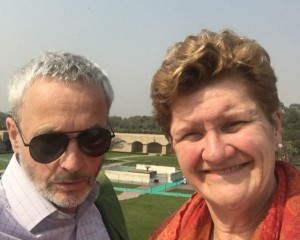 In the afternoon we saw India Gate and Mahatma Ghandi’s memorial site. Both were in their different ways very impressive. Delhi, though, fails to impress: the pollution is terrible, the streets filthy, there are lots of stray dogs, and lots of hassles from people desperate to sell you something that you don’t want.
In the afternoon we saw India Gate and Mahatma Ghandi’s memorial site. Both were in their different ways very impressive. Delhi, though, fails to impress: the pollution is terrible, the streets filthy, there are lots of stray dogs, and lots of hassles from people desperate to sell you something that you don’t want.
Off to Jaipur tomorrow.
Jaipur. We travelled by train from Delhi to Jaipur (my choice – against the advice of our Indian friends and to the surprise of the Mumbai-based travel agent).
Getting to New Delhi Railway Station at 0530 was the easy bit. Then we had to find where to go (easy, look for the train on the electronic board) and where to stand to get on the right coach. Not obvious on the platform. Back to the entrance. “Helpful” tout tells us our e-ticket isn’t valid, and we’ll have to go in his tuk-tuk to some other office, but he backs off when I start to ‘phone our travel agent. We go to the “International Travellers Help Desk”, which turns out to be a room with two people asleep on the couches. Someone else comes in (along with an Indian person guiding him) and wakes up one of the two scruffy people on the coaches, who turns out to be the official! After dealing with the other traveller, he eventually agrees our tickets are in order, but can’t explain to us how to find our coach and booked seats. We go back to the platform. The train is already there with 20 min. still to go. A dishevelled-looking man comes and sticks passenger names on dot-matrix printouts onto the coach sides. We find our coach and seats and get on with relief.
After that, the train journey was wonderful. Going slowly out through the suburbs, we see the appalling two-storey shanty towns by the railway tracks, some of them right on the tracks, with people waking up, washing (!) and getting dressed ON the tracks. These are “live” tracks, because further on we saw a moving goods train on the same line, moving slowly in the same direction as us, fortunately! Rubbish everywhere. This is a common theme of this trip, though: in the days when rubbish was paper and wood, it eventually degraded. Now it is mostly plastic. Later on, gradually the scene changes through the poor suburbs, the better ones, and then out into the country. Rajasthan is dry, dry, dry, flat, flat, flat. Until nearer to Jaipur, when small hills intermittently appear out of the flat landscape. A great journey.
Then we arrive in Jaipur Junction. Our driver greets us on the train: he gets onto the carriage and greets me by name.
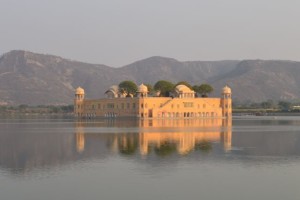 Our hotel is superb – See the picture from our window, looking over the Jal Mahal palace, which appears to float in the lake.
Our hotel is superb – See the picture from our window, looking over the Jal Mahal palace, which appears to float in the lake.
Alas, the vision is better than the personal experience: you cannot smell a picture. The lake is polluted and smelly. The water level is low (poor monsoons for three years) and there are colonies of rats burrowing into the banks by the road. We saw a local feeding them!
A slightly downside to the first day was the carpet-selling experience. It was an Third-World classic. Our driver takes us to a carpet factory where we are told how it employs all the local families, etc. [sympathy]; then we are given water bottle, and tea to drink [obligation]; “Sit down, and we will show you some of our (local) carpets” [play the local ideology card]. How much? Well, “we’ll quote in Australian dollars, and give you a good exchange rate” [but then charge your card in rupees – and it’s back to the banks’ rates]. Shipping and insurance is part of the price. Play one foreigner off against the other.
We bought a carpet anyway: Sue knew at the time that it was good value by Australian standards, although I did not of course, and was uncomfortable about the whole thing – to me it seemed very expensive, and I was aware of the potential scam, although Sue was also, of course.
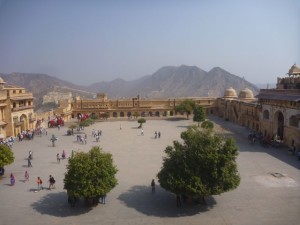 We next day we had a guide around Jaipur, who was very good. Took us to the Jaighur Fort and the Amber palace and fort, which were deeply impressive and often beautiful as well.
We next day we had a guide around Jaipur, who was very good. Took us to the Jaighur Fort and the Amber palace and fort, which were deeply impressive and often beautiful as well.
The bazaars are good (carpets excepted!). The palaces and museums excellent. The food really good. I had a stuffed paratha for breakfast this morning – really tasty.
Next, onto Pushkar.
Pushkar.
We set off from Jaipur this morning towards Udaipur. We had a planned stop at a town called Pushkar, about halfway from Jaipur to Udaipur.
We started off in traffic jams in Jaipur. It reminded us that Jaipur has nearly the same population as Sydney. Once out of Jaipur we were on motorway. Not the sort of motorway that you get elsewhere: after all, where else could you see someone shepherd a herd of goats across the motorway! Then we went off down a sideroad to visit our driver’s village, which was interesting.
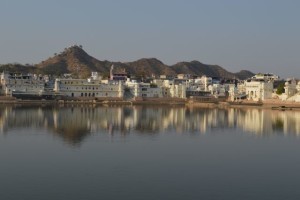 Pushkar turned out to be more interesting than I expected. A journey into the past, it was like going back to India or Nepal from the early 80s! More whiteys than we’ve seen all the rest of the trip put together, and in tie-die shirts (I’m not joking), John Lennon glasses and those stripy baggy trousers drawn in at the ankles which I’ve forgotten the name of. Incense sticks, multicoloured bangles and textured waistcoats on the market stalls. You might be getting the picture by now. Sue tells me that she saw a scruffy young western woman dressed in rags but who spoke with a plummy Home Counties accent. There’s even a Pink Floyd Cafe. Well, I Wish You Were Here to see it all, it’s quite extraordinary !
Pushkar turned out to be more interesting than I expected. A journey into the past, it was like going back to India or Nepal from the early 80s! More whiteys than we’ve seen all the rest of the trip put together, and in tie-die shirts (I’m not joking), John Lennon glasses and those stripy baggy trousers drawn in at the ankles which I’ve forgotten the name of. Incense sticks, multicoloured bangles and textured waistcoats on the market stalls. You might be getting the picture by now. Sue tells me that she saw a scruffy young western woman dressed in rags but who spoke with a plummy Home Counties accent. There’s even a Pink Floyd Cafe. Well, I Wish You Were Here to see it all, it’s quite extraordinary !
Onto Udaipur tomorrow.
Udaipur.
Well we are at our hotel in Udaipur now. Having said that Pushkar was like the 1980s (or 70s or 60s), this like going back to the 1930s! Shikarbadi Hotel used to be a maharajah’s hunting lodge/palace, and so is a hotel with a swimming pool, a stable (complete with thoroughbred polo ponies), a deer park, a polo field, and its own airport (complete with control tower)!
The worst thing so far is the noise of the monkeys on our roof. I just hope that they sleep well at night.
The journey down was pretty uneventful. The countryside around Udaipur is much less flat than around Jaipur, and looks much more fertile and productive.
Into Udaipur itself tomorrow.
We start at the Shikabadi hotel. Fortunately the monkeys also slept, until the morning climbing expedition over our roof.
The hotel is an art-deco tribute to the wealth of the maharanis (there a distinction between these and maharajahs, who are less warlike). The palace as it was has its own cricket pitch, polo field, stables, deer park, airport, and before the withdrawal of the princes’ privileges in 1971 it must have been the equivalent of any current millionaires country retreat anywhere.
Actually on the evening of our arrival the Marani of Mewar was having a friendly game of cricket on his pitch. He’d been brought there in his immaculately polished customised (Rokit-HC) white Range Rover. His personal staff were there, and although he looks just a ordinary guy (and was a very “ordinary” wicketkeeper), he clearly is NOT.
 Today we went to the City Palace and Museum, which comprise the buildings seen in classic pictures of Udaipur. Actually the smart looking half is the 25-star hotel (10%) and the Maharani’s personal section (40%). The whole complex is both beautiful and deeply impressive. We also went on a boat ride to the Jagniwas Island (and around the five-star hotel made from the summer palace – another common picture of Udaipur). It really is a beautiful lake and surrounding scene.
Today we went to the City Palace and Museum, which comprise the buildings seen in classic pictures of Udaipur. Actually the smart looking half is the 25-star hotel (10%) and the Maharani’s personal section (40%). The whole complex is both beautiful and deeply impressive. We also went on a boat ride to the Jagniwas Island (and around the five-star hotel made from the summer palace – another common picture of Udaipur). It really is a beautiful lake and surrounding scene.
Tonight we will go out to eat at a lakeside restaurant. Lots of mosquito-repellent will be applied, I think!
Ambrai Restaurant was good, but mainly for its position: looking out over the main lake in central Udaipur. It is at water level, looking over to the City Palace and over to the Jag Mandir island with it snow-White luxury hotel. The main problem was getting there (and back): we had to walk along very narrow streets with tuk-tuks hurtling by, dogs, cows, and shop sellers hawking their wares. The return walk at 9pm was particularly trying.
The setting was superb, the food ordinary. The biryani just tasted like rice and vegetables, the other dishes almost just as bland. We’ll eat at the hotel tonight. We were advised against eating breakfast outside this morning because “there is a problem with monkeys”, but apparently they have gone by the time of an evening meal!
We went to Shilpgram Village outside Udaipur today. It is an area set up with typical houses from various parts of Rajasthan, with artists and craftsmen demonstrating and selling their wares. Needless to say, some items were secured for the new house, the Christmas tree (!), etc.
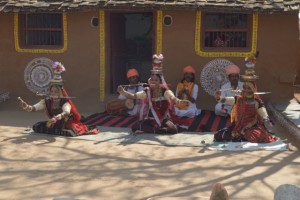 There were also some interesting dances, especially by the Devlas, but I couldn’t work out how to get the video on our Nikon SLR to work in time (simply pressing the red button didn’t seem to be enough!). Three young women swinging themselves around whilst holding knives between their teeth and balancing things on their heads!
There were also some interesting dances, especially by the Devlas, but I couldn’t work out how to get the video on our Nikon SLR to work in time (simply pressing the red button didn’t seem to be enough!). Three young women swinging themselves around whilst holding knives between their teeth and balancing things on their heads!
We then went back to Udaipur and wandered through the backstreets of the old part of town, much to our driver’s distress. He was clearly worried that we would either succumb to the wiles of an underhand shopkeeper, or be mugged! Fortunately neither happened, and we enjoyed a couple of hours just walking around. We bought nothing!
To the Monsoon Palace tomorrow, then we start home.
We are on our way home. I’m typing this in Udaipur Airport, having gone through security. Over an hour to wait for the flight to Delhi.
We’ve just said goodbye to the driver, Raju, who was with us since Jaipur. If you leave a gratuity/tip, what should it be? What is a reasonable amount to us creates distortion in the economy – if employers know employees are being given thousands they pay less and then when a tip is NOT given, the employee has worked for a pittance or for nothing – but to give what is a small amount to us (though good to the recipient) seems inadequate to the giver as a reflection of the service given. I don’t know the answer. Does anyone? Answers on a postcard, to ….
 We went to the Monsoon Palace this morning, perched on the top of the highest hill near Udaipur. Somewhat run down and dilapidated it is a good place to visit nevertheless. Great views over the area, and an interesting palace in itself. All the rainwater is carefully collected in vast tanks under the palace – because getting there, or getting anything like water there, is to struggle up a long, very tortuous road from Udaipur.
We went to the Monsoon Palace this morning, perched on the top of the highest hill near Udaipur. Somewhat run down and dilapidated it is a good place to visit nevertheless. Great views over the area, and an interesting palace in itself. All the rainwater is carefully collected in vast tanks under the palace – because getting there, or getting anything like water there, is to struggle up a long, very tortuous road from Udaipur.
After that we went to another textile shop. The remaining cash was “burning a hole in [Sue’s] pocket”, but we’ve managed to deal with that.
So, my impressions of India?
Firstly, Indians have so much to be proud of: the vibrant society, the incredible history, the people as a whole, the increasing belief that India is beholden to no-one and dependent on no-one. Yet there are problems: the Thatcher-like idea of wealth being generated at the top to trickle down to those below means that it would take centuries to reach those in the shanty towns by the railways; the pollution – everywhere is in a sort of haze, least noticeable in Udaipur, worst in Delhi of course; the half-hidden commissions and kickbacks that make me wary of anyone’s motives.
They are just like us (Aus. or Anglo.) and have a sense of humour. One of the guides asked me “what is heaven and what is hell”? I was looking for a Hindu definition when he continued on: “Heaven is an American salary, German car, Chinese food and an Indian wife. Hell is an Indian salary, a Chinese car, German food and an American wife.”
OK, I said a sense of humour, I didn’t qualify good, bad, etc., but it still distinguishes them from Americans, etc.
